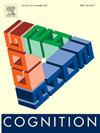与人工智能体的语言一致性:评论与再分析
IF 2.8
1区 心理学
Q1 PSYCHOLOGY, EXPERIMENTAL
引用次数: 0
摘要
在本文中,我们对Cirillo等人(2022)在涉及社交机器人的联合图片命名任务中的概念对齐研究(认知,227,105,213)提供了评论和补充分析。在他们的研究中,Cirillo和合作者提供了通过检查反应比例来自动对齐的证据,反映了人工代理对词汇选择的适应(即,为特定的语义类别提供类别名称而不是基本名称)。在这里,我们使用公开可用的数据集进行了补充分析,采用多元宇宙方法,并将重点放在响应时间上,作为认知处理和自动性的更细致的衡量标准。我们的研究结果表明,在类别条件下的对齐(即,当机器人提供上级标签时)与更长的响应时间和更大的可变性相关。在basic条件下提供基本标签时,RTs要短得多,变异性减少,与basic级优势现象相一致。不与每个条件对齐完全颠倒了模式。这表明,当产生上级标签时,调整是一种战略和努力,而不是一种自动反应机制。此外,通过对潜在影响变量的反应比例进行全面的视觉探索,我们观察到类别命名一致性主要出现在特定的语义类别中,并且主要出现在具有低词汇频率的基本标签的刺激和新设计的图片中,因此表明该效应具有有限的普遍性。这些见解是通过留一鲁棒性检查得到证实的。总之,我们的贡献提供了补充证据,支持在与分析数据集中的类别标签保持一致时的战略反应,而不是自动反应,尽管作者在实验材料中仔细实施了所有平衡程序,但概括性有限。这可能反映了个人的任务策略,而不是真正的一致性。最后,基于Cirillo等人的研究和我们的评论,我们提出了未来语言一致性研究的方向。我们还简要讨论了影响我们工作方法的开放科学原则。本文章由计算机程序翻译,如有差异,请以英文原文为准。
Linguistic alignment with an artificial agent: A commentary and re-analysis
In this manuscript we provide a commentary and a complementary analysis of Cirillo et al.'s (2022) study on conceptual alignment in a joint picture naming task involving a social robot (Cognition, 227, 105,213). In their study, Cirillo and collaborators present evidence suggesting automatic alignment by examining response proportions, reflecting adaptation to the lexical choices made by the artificial agent (i.e., providing category names instead of basic names for specific semantic categories). Here, we conducted a complementary analysis using the openly available dataset, employing a multiverse approach and focusing on response times as a more nuanced measure of cognitive processing and automaticity. Our findings indicate that alignment in the Category condition (i.e., when the robot provided a superordinate label) is associated with longer response times and greater variability. When providing the basic label in the Basic condition, RTs are much shorter and variability is reduced, compatible with the Basic-level advantage phenomenon. Non-alignment to each condition completely reverses the pattern. This suggests that aligning when producing a superordinate label is a strategic and effortful rather than an automatic response mechanism. Furthermore, through comprehensive visual exploration of response proportions across potentially influential variables, we observed category naming alignment primarily emerging in specific semantic categories, and mostly for stimuli with basic labels at low lexical frequency and newly designed pictures not taken from the MultiPic database, thus suggesting a limited generalizability of the effect. These insights were confirmed using leave-one-out robustness checks. In conclusion, our contribution provides complementary evidence in support of strategic rather than automatic responses when aligning with Category labels in the analyzed dataset, with a limited generalizability despite all the balancing procedures the authors carefully implemented in the experimental material. This is likely to reflect individual task strategies rather than genuine alignment. Lastly, we suggest directions for future research on linguistic alignment, building on insights from both Cirillo et al.'s study and our commentary. We also briefly discuss the Open Science principles that shaped our approach to this work.
求助全文
通过发布文献求助,成功后即可免费获取论文全文。
去求助
来源期刊

Cognition
PSYCHOLOGY, EXPERIMENTAL-
CiteScore
6.40
自引率
5.90%
发文量
283
期刊介绍:
Cognition is an international journal that publishes theoretical and experimental papers on the study of the mind. It covers a wide variety of subjects concerning all the different aspects of cognition, ranging from biological and experimental studies to formal analysis. Contributions from the fields of psychology, neuroscience, linguistics, computer science, mathematics, ethology and philosophy are welcome in this journal provided that they have some bearing on the functioning of the mind. In addition, the journal serves as a forum for discussion of social and political aspects of cognitive science.
 求助内容:
求助内容: 应助结果提醒方式:
应助结果提醒方式:


